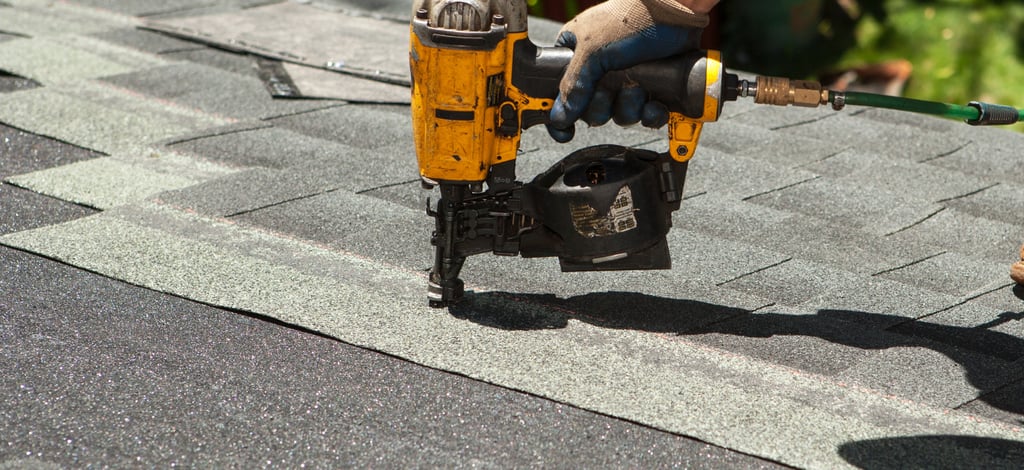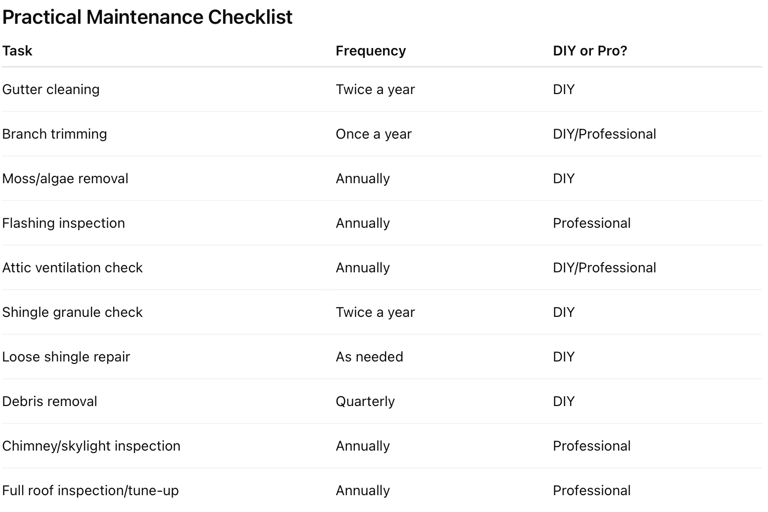Keep Your Roof in Top Shape: Expert Answers and Maintenance Tips
Your Guide to Common Roofing Questions and the Top 10 Ways to Protect Your Home’s First Line of Defense
8/5/20253 min read


Maintaining a healthy roof is one of the best investments you can make in your home. After 30 years in the roofing business, I’ve seen everything from minor leaks to complete blow-offs in high winds. In this post, I’ll share the most common questions homeowners ask, along with clear answers, and my top ten tips for keeping your roof in tip-top shape. Whether you’re a first-time homeowner or just looking to extend the life of your existing roof, these insights will help you stay ahead of potential problems.
Common Questions & Answers
Q1: How often should I have my roof inspected?
A: At a minimum, you should schedule a professional inspection once a year. Spring and fall are ideal, since they follow the harsh winter and summer seasons respectively. If you live in a region with severe storms, consider an extra check after any major weather event.
Q2: What are the warning signs of roof damage?
A: Look for missing, cracked, or curling shingles; granules in your gutters; dark streaks on roof surfaces; and any signs of water stains on attic rafters or interior ceilings. Early detection is key to preventing costly repairs.
Q3: Can I walk on my roof to inspect it myself?
A: While homeowners sometimes feel tempted to climb up, walking on asphalt shingles can cause damage if you’re not experienced. If you must inspect yourself, wear soft-soled shoes, step only on the lower third of the shingle, and proceed with extreme caution. Hiring a pro is safer and more thorough.
Q4: How do I know if I need a full roof replacement versus a repair?
A: Minor issues—like a few damaged shingles or flashing that needs resealing—can often be fixed with a simple repair. However, if more than 30% of your shingles are damaged, you’re seeing widespread leaks, or your roof is more than 20 years old, replacement is likely the more cost-effective option.
Q5: Does roof maintenance really extend its lifespan?
A: Absolutely. Regular maintenance can add five to ten years to a roof’s life. Clearing debris, checking flashings, and ensuring good attic ventilation all help your roof withstand weather and reduce the risk of premature aging.
Top Ten Roof Maintenance Tips
Clean Your Gutters and Downspouts
Debris buildup in gutters causes water to overflow and pool near the roof edge, leading to rot and ice dams in winter. Clean at least twice a year (spring and fall), and remove leaves, twigs, and any other obstructions.Trim Overhanging Branches
Branches that rub against shingles scratch away protective granules and create easy pathways for pests. Keep branches at least six feet away from the roof to prevent damage and discourage squirrels or raccoons from gaining access.Remove Moss, Algae, and Lichen
These growths trap moisture on the roof surface and can lift shingles. Use a soft wash solution (a mix of water and mild bleach or a commercial moss killer) applied carefully from below. Always follow safety protocols when working on your roof.Inspect Flashings and Seals
Flashings—those thin metal strips around chimneys, vents, and skylights—are critical for waterproofing. Check for cracks, rust, or lifted edges, and reseal with high-quality roof cement or replace if necessary.Check Attic Ventilation
Proper airflow prevents heat and moisture buildup, which can warp wood, rot sheathing, and shorten shingle life. Ensure soffit vents and ridge vents are clear and functioning. A quick attic visit after a rainstorm can reveal leaks before they reach your living space.Look for Granules in Gutters
Granules from asphalt shingles protect against UV rays and heat. If you’re finding large amounts of granules in your gutters, your shingles may be wearing out. This is often a sign that replacement is on the horizon.Secure Loose or Missing Shingles
High winds can lift shingles. If you notice any loose ones, re-nail them with galvanized roofing nails or use roofing cement to hold them down. Replace missing shingles promptly to avoid water intrusion.Keep the Roof Clear of Debris
Fallen leaves, pine needles, and construction materials all trap moisture and accelerate shingle wear. Sweep or blow off debris regularly—especially after storms or in the fall when leaves are abundant.Inspect and Maintain Chimney and Skylight Flashing
Chimneys and skylights are common leak points. Examine the surrounding flashing and the mortar joints of the chimney. Repair deteriorated mortar with appropriate mortar mix and reseal skylight flashing annually.Schedule Professional Inspections and Tune-Ups
Even if you’re handy, a professional roofer brings trained eyes and specialized equipment to catch issues you might miss. A seasonal tune-up can include minor repairs, resealing, and a detailed inspection report to keep you informed.
Why Maintenance Matters
Cost Savings: Preventative maintenance costs a fraction of emergency repairs or complete replacements. A few hundred dollars spent annually can save thousands down the line.
Energy Efficiency: A well-maintained roof helps regulate attic temperature, reducing heating and cooling costs.
Home Value: When it comes time to sell, buyers will appreciate the documented care you’ve given your roof. A roof in good shape enhances curb appeal and can even speed up the sale process.
Safety: Leaks and structural damage can lead to mold growth and weakened decking, posing health and safety hazards. Regular upkeep keeps these risks at bay.


Ready to protect your home for years to come? Schedule your FREE roof inspection today and let our experts keep you covered! Call 585-820-7022 or fill out the form below.
dpcustomsny@gmail.com
585-820-7022
© 2025. All rights reserved.
